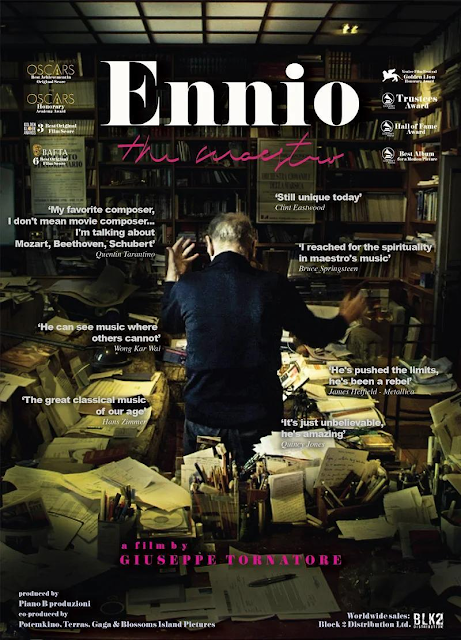Thursday, June 13, 2024
Ennio Morricone, the Maestro of the Movie Soundtrack, Gets the Entrancing Documentary He Deserves
The subject is one of the most innovative and influential composers of all time but the documentary that tells his story is very conventional, with chronological archival footage and talking head interviews given by the composer and his co-workers. The subject is Ennio Morricone, composer of over 500 movie scores, and the talking heads include Clint Eastwood, Bruce Springsteen, Oliver Stone, and Quentin Tarantino. But the star of the film is the music itself. We hear Morricone try to explain a musical theme by going, “duh duh de duh duh” and then we hear what is in his head, the full orchestration, with the movie scene it immeasurably enhances.
The term “spaghetti western” inevitably calls up the image of the man with no name, played by Clint Eastwood with a serape, a cigar, and a thousand-yard stare. And it also calls up that defining musical theme, the one with the whistle, like nothing that had ever been heard in a cowboy movie before. Yes, one of the talking heads is the guy who got the phone call from Morricone saying he needed “a little whistle,” smiling as he tells us it was more than a little.
Morricone tells us he had no dreams of being a musician when he was a child. He thought he would like to be a doctor. But his father, a musician who supported the family as a trumpeter, sent him to music school to study the trumpet. Morricone casually mentions that during this period, “The Germans were here, and then the Americans,” meaning World War II, just about the only reference in the film to anything outside of the world of music.
Morricone’s father became ill, and the young music student had to support the family by taking over his father’s jobs. But back at school he was drawn to composing, learning the traditions and then challenging them. “I didn’t stick to the rules,” he tells us. “I enriched them. I made them flourish.” He was drawn to modernist rule-breakers like Igor Stravinsky and pioneers of indeterminacy who made everyday objects like a typewriter or a creaky ladder into musical instruments. “We wanted to make traumatic sounds,” he says.
Morricone began to transform the way musical accompaniments for pop singers were created. One of the experts explains that unlike the tradition of using the instruments to track the chords of the vocal, Morricone “was trying to find something superior to the song itself.” His arrangements were not just following the notes of the song; they were in conversation with them, challenging them, adding complexity and depth. He became so successful he worked with international stars like Paul Anka and Chet Baker.
He did put one limit on himself. Out of concern for his father, who still was not able to play professionally, he kept trumpets out of his arrangements and compositions so he would not have to turn his father down for a job.
And then her got a call from spaghetti western director Sergio Leone. Their meeting turned into a reunion; they had been classmates in elementary school. And they began to work together. Eastwood, himself a jazz afficionado and composer, talks about how surprised he was when he saw the film and heard the unusual “operatic” score that included the sound of a cracking whip, an electric guitar, an anvil, and the iconic whistle. “This music helped dramatize me, which is hard to do,” Eastwood says.
Morricone began to be offered the composing jobs that his music teachers used to get. One admits, “We were archaic.” He preferred to work with first-time directors, who let him take more chances. His orchestrations included vocal soloists and choirs. Also coyote howls. His first American film score was John Huston’s “The Bible” in 1966.
The film is written and directed by Giuseppe Tornatore, whose film, “Cinema Paradiso,” features one of Morricone’s most beloved scores. The comments he gets from musicians, composers, and directors are mostly long on unabashed admiration but light on insight. When Tarantino and Quincy Jones say he is their favorite composer and Springsteen says, “I’m still learning from him,” we wish for more specifics and insights. It is interesting to hear from director Roland Joffé (“The Mission”) that Morricone attacks the music staff writing paper “like an athlete,” rapidly filling in the notes with furious energy, and from another that he does not actually need a piano when he composes; he can play imaginary keys and hear the music in his head.
There is a brief, intriguing section near the end showing Morricone’s influence on broader culture, coming full circle when his melodies are adopted by pop stars and even metal legends Metallica. More rewarding for the composer was finally winning a competitive Oscar in 2016 for “The Hateful Eight” after five nominations and an honorary Oscar in 2007. But what means the most to him is seeing his work performed in concert with full orchestras, transcending the category dismissed by his professors as less prestigious or legitimately creative. The music that adds so much to the images and characters on screen is just as meaningful on its own.
Subscribe to:
Post Comments (Atom)


No comments:
Post a Comment